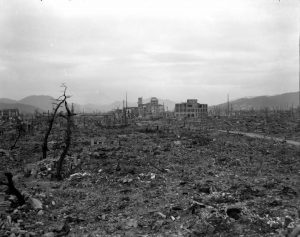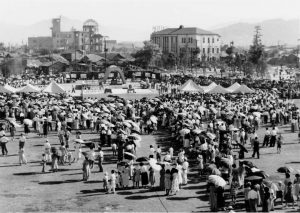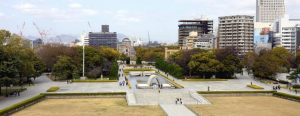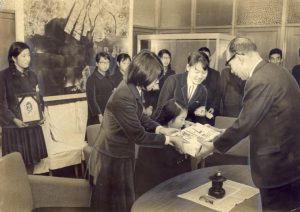50 Days until Hiroshima Summit from May 19 through 21: Restoration of the city “back then”
Mar. 30, 2023
Lessons learned in reviewing the journey of Hiroshima's restoration
by Michiko Tanaka and Kyosuke Mizukawa, Senior Staff Writers
They wish to learn from Hiroshima’s resilience. For many parts of the world that have never-ending wars and conflicts, the A-bombed city is always a place of hope. On August 6, 1945, Hiroshima was completely destroyed by the detonation of a single atomic bomb dropped by the U.S. military. How was the city restored from this devastating condition, which someone once described by saying no grass nor tree would grow over the following seven decades? What lessons can we learn from it? Now it is 50 days to go until the summit meeting of the G7 (Group of Seven industrialized nations) which will bring together leaders from Japan and overseas. The Chugoku Shimbun wants to revisit the city’s post-war journey once again.
First post-bombing streetcar operated three days later
Every scene she saw through the streetcar window was of burned ruins. On August 9, 1945, Satoko Sasaguchi, 92, a resident of Nishi Ward, served as conductor for the streetcar which resumed operation between Koi and Nishitenma-machi stations on that day. She was then 14. Ms. Sasaguchi reflected back that time and said, “The street car company told me it was free of charge. Some passengers looked very pleased and said a word of thanks to me.”
In the history of Hiroshima Electric Railway Co., Ltd. located in Naka Ward, it was recorded that the company lost 185 of its employees to the atomic bombing with 108 of 123 street cars on the downtown lines damaged. But it was able to run the “first street car after the atomic bombing” three days later. It extended its operating area step by step and achieved full recovery of the line between Koi and Hiroshima stations in the middle of October.
According to the city’s Record of the Hiroshima A-bomb War Disaster, the Hiroshima Railway Bureau of the Japan Ministry of Railways made an all-night effort for railway recovery. On August 6, a rescue train ran between Hiroshima and Saijo stations. On August 7, the Ujina Line got back to its normal operation schedule. Train operation restarted for the Sanyo Line on August 8 and the Geibi Line on August 9.
Outages throughout the whole city were resolved gradually. The transmission of electricity was restored to the Ujina area, which had some military facilities, on August 7, and the Hiroshima station area on August 8. By the end of November, lights could be on at all houses remaining in the city. With regard to water, electrical equipment at the Ushita water purification plant located 2.5 kilometers north from the hypocenter was broken, having ceased the pump operation necessary for water supply. But the staff at the plant made urgent repairs to the spare pump and kept the water supply without any stoppage.
The citizens who supported those restoration activities were injured by the atomic bombing too. When the bomb detonated, Ms. Sasaguchi was trapped under a collapsed building as she was in the dining room of the dormitory at the Girls’ School of the Hiroshima Electric Railway located in Minami-machi (now part of Minami Ward). At an evacuation shelter, she administered care to her company’s injured employees who had been sent to her one after the other. With a little pride, she said, “We were still at war. So, I thought I had to be of help in winning the war. Also, everyone around that time had a very strong mind.”
“A-bomb Dome should be a symbol” as witness of tragedy. Wishes of the architect and the public for peace were gathered together
Hiroshima’s Peace Memorial Park in Naka Ward is a place symbolic of Hiroshima, a city full of greenery. The park area is about 120,000 square-meters, centering on the “former Nakajima district,” a delta between the Motoyasu and Honkawa Rivers. Before the bombing, shops and private houses were lined up in the district, but totally annihilated because they were very close to the hypocenter. In 1949, four years after the atomic bombing, a park development initiative formally kicked off for the area, where A-bombed remnants are still buried underground.
With a pledge that reads, “Hiroshima city will be rebuilt as a World Peace Memorial City” (excerpted from the guidelines for the park’s design proposal submission), the City of Hiroshima tried to build a “most appropriate” peace memorial park, and started to receive applications for park design proposals in May 20, 1949. The guidelines made it a requirement to build a “Peace Memorial Hall.” It was assumed this hall would be used for holding international conferences related to peace movements and collecting A-bombed materials.
The magnificent concept was closely connected to the Hiroshima Peace Memorial City Construction Act, which was drafted based on requests from the city and its council and enacted in the Diet session on May 11 that year, just before the beginning of the application period for park proposals. The Act got a majority vote in a local referendum held for the first time under the current constitution, and was promulgated on August 6. It aimed at rebuilding Hiroshima as a peace memorial city that symbolizes lasting peace, and stipulated that relevant organizations, including the national government, should provide assistance as much as possible.
In alignment with this move, the application of the design proposal drew the attention of many people, resulting in 145 applications received. First prize went to a proposal submitted from a group led by the late Kenzo Tange, an architect and then assistant professor at the University of Tokyo. With that team’s idea, the A-bomb Dome (called Hiroshima Prefectural Industrial Promotion Hall at the time of the bombing) was positioned on an extension of an axis line drawn between the main building of the current Peace Memorial Museum and the Cenotaph for the A-bomb victims.
“The atomic bombing was shocking to me. (Omission) I have this idea that peace can be created only after the terror and horrible nature of the atomic bombing is understood by people. That’s why we designed the park by using the dome as an iconic symbol,” said Mr. Tange in an interview for the Chugoku Shimbun’s feature titled “History of Hiroshima” (published in 1995). He went to the former Hiroshima High School (now Hiroshima University) and became a renowned architect representing Japan after the end of the war.
The central government provided financial support for development. In 1952, the Cenotaph for the A-bomb Victims was built, and became a place for Peace Memorial ceremonies. In 1955, the Peace Memorial Museum opened. However, with regard to the dome, the key building in the design, some citizens still wanted to have it dismantled, arguing they did not want to recall the tragedy of the A-bombing.
Under these circumstances, the “Hiroshima Paper Crane Club” (consisting of students at schools in the city) began a signature drive in August, 1960, calling for preservation of the dome. Club members were driven by the journal left by Hiroko Kajiyama, a girl who experienced the atomic bombing when she was one year old, and then died due to A-bomb-induced leukemia in April, 1960 at age of 16. Ms. Kajiyama wrote, “Only that painful industrial promotion hall would permanently convey the horribleness of the atomic bombing to the world.”
The public opinion leaned toward the direction of preservation by degrees. In 1966, the city council resolved that preservation of the dome was a duty toward later generations, and the debate over the fate of the dome ended. Eiko Mikami, 76, a resident of Minami Ward who joined the club and worked on the signature drive, said, “What I was pleased with the most back then was the fact that Hiroko’s wish finally came true.”
The A-bomb Dome has absorbed the thoughts of A-bomb victims who were forced to experience the atomic bombing. It continues to be a witness of catastrophe after going through preservation work five times previously and after inscription to the World Heritage List in 1996. However, amid the current situation wherein Russia is expressing its readiness to use nuclear weapons after its invasion of Ukraine, Ms. Mikami said, “I think the dome is crying now.”
When the leaders attending the summit are faced with the Cenotaph for A-bomb Victims and follow the axis line drawn by Mr. Tange, they will see the A-bomb Dome in front of them. What will they feel and how will they act then? The seriousness of the leaders gathering for the Hiroshima summit will be tested.
Delivery of a message to the world as a peace city
The city’s initiative began on a full scale in the 1970s. The number of member cities of Mayors for Peace reached 8,240.
The city that spreads the will for peace around the globe. This is one of the ideal city images the city of Hiroshima has pursued since 1970s. Around that time, the city began to convey its message of peace to the world on a full scale.
In 1976, Takeshi Araki, then Hiroshima Mayor and an A-bomb survivor, went to the headquarters of the United Nations (U.N.) in New York for the first time and negotiated with Secretary General Kurt Waldheim in person for the elimination of nuclear weapons. In 1982, Mr. Araki proposed to form solidarity among the cities across borders in a U.N. Special Session on Disarmament in 1982. His speech in the session led to the establishment of the World Conference of Mayors for Peace through Inter-city Solidarity, the predecessor of Mayors for Peace.
“We wish to pledge ourselves to the promotion of an even deeper understanding of all that ‘Hiroshima’ stands for.” (Excerpts from Peace Declaration by then Mayor Takashi Hiraoka in 1993). “We will continue to ensure the world abolishes all nuclear weapons without delay.” (Excerpt from Peace Declaration by then Mayor Tadatoshi Akiba in 2000). Successive Hiroshima mayors promoted initiatives to have international people visit the A-bombed city, by not only visiting other nations for appeal themselves, but attracting international conferences to Hiroshima.
The city has invited nuclear-armed nations since 1998 and all ambassadors to Japan since 2006 to the Peace Memorial Ceremony. The number of member cities of the Mayors for Peace has ballooned to 8,240 from 166 nations and regions (as of March 1).
It was considered the name of Hiroshima had become widely known to the public, and the number of international tourists visiting the Peace Memorial Museum marked a record-high seven years in row, consecutively, until fiscal 2019. However, afterwards, it sharply declined because of the Covid-19 pandemic. An officer at the City’s tourism policy department said, “The summit is a good opportunity to draw people’s attention to our city.” The city is attempting to invite more international tourists through the intensified PR activities of “Peace Tourism” in which tourists go around the traces of the atomic bombing and the facilities symbolizing the restoration of Hiroshima.
Layout: Riho Masuda
Graphics: Hayato Otomo
(Originally published on March 30, 2023)











